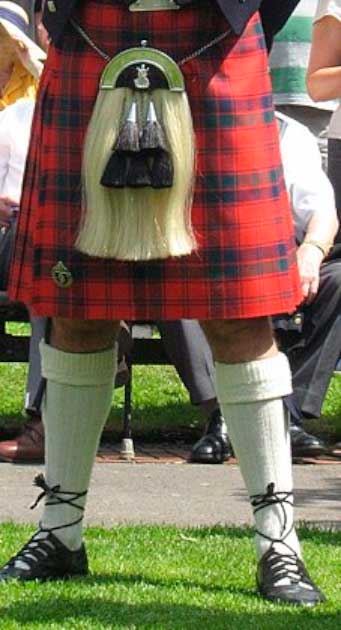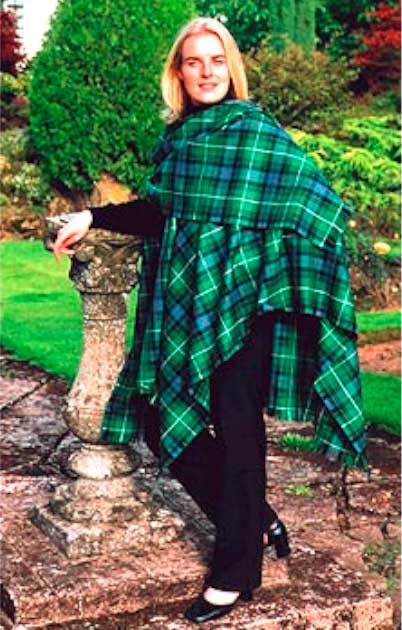There are surely few things as distinctively Scottish as tartan. The hard wearing, patterned cloth with its horizontal and vertical bands in multiple colors, a pattern known as sett, is visually arresting and an established part of the Scottish cultural identity.
Tartan cloth was originally woven in wool and is mostly associated with traditional Scottish attire. The cloth is also called “plaid” in North America, although for the Scots this is a very different material. Plaid is not the pattern, but rather a long tartan cloth that men wear as shawls or Scottish kilts when they dress up traditionally. The word plaid is also used to describe a simple blanket on a bed in Scottish homes.
The design and style of tartan gives rise to the opportunity for endless variety, and indeed each of the traditional and ancient noble families of Scotland has their own design, varying in color and spacing, but always square and always distinctively tartan. You would think such a tradition was as old as the Scottish hills. But is it?
The Origins of Tartan
There has always been something like a tartan in Scotland, and certainly the Scots always had a need for a heavy cloth: it gets very cold up there. The word “tartan” originates from the Gaelic word “breacan”, which means “checkered” in the ancient language. This original cloth can trace its history back to three thousand years ago when the original tartan weave came into existence.
Tartan cloth has been popular in all parts of Scotland over the years. However, the patterned cloth is particularly popular as a garment in the Scottish Highlands, which is why it has become synonymous with the clan system.
Tartan became a part of the traditional Scottish attire when the kilts or philabeg were developed using this cloth. Scottish traditional dress has many aspects and is very distinctive: a tartan kilt was originally worn with untanned hide shoes and knee-length, calf-hugging boots known as “cuaran” fastened with thongs, although today high socks and shoes are more common.

Clansmen would also wear a woolen hat or bonnet that had the clan symbol, usually a flower sewn on it. Another item of clothing or a popular accessory for clan members was a highly decorated leather purse called the sporran. Men would wear the sporran purse in front of their kilts and use it to store essentials.
- How the Darien Scheme Changed the History of Scotland’s Independence
- Sawney Bean: The Scottish Clan of Cannibals
Not only clansmen but women of the clan would also wear tartan clothing in their daily lives. For example, a clan woman would wear a tonnag, a small piece of Tartan cloth on her shoulders. Her outfit would also include a curraichd of linen worn over her head and fastened under the chin like a scarf.
The women also wore arasaid, a head to ankle garment often made of tartan that was pleated around the breast and cinched at the waist with a sturdy belt. The women would wear a brooch as an accessory and to hold the dress together.
The Creation Of Clan Tartan
Early examples of tartan clothing used to have simple patterns with the sett made of two or three colors. While today, we use artificial colors to create the distinctive colored patterns, earlier, weavers used to dye the cloth with natural colors, extracted from dye-producing plants and roots.
Even berries and tree barks were used to color the earliest tartan clothing. Every district used to have weavers that used to create clothing with a distinct tartan sett. This distinct pattern was only worn by the native residents of the district or region. Therefore, the tartan clothing became a part of the identity of the local residents.
People of one region could be distinguished from other regions’ people from their unique tartan colors and patterns. Each district created its own clan, and slowly, tartan patterns became associated with the symbol of the clan. Different clans had different clan tartans that members used to wear.
Tartan held a lot of importance in local culture, and weavers had to be able to reproduce them with accuracy in color and pattern. Weavers would pay a lot of attention to getting the pattern and color right because the Tartan was inextricably linked to the identity of a clan.
They would lay out woolen threads of the exact color as ordered and make a sett with exacting detail and then repeat it. Today, when we have machines, this process is relatively easy and smooth going. However, when the pattern and clothes were woven by hand, this would be very painstaking, and a good weaver was highly prized.
As clans grew and branched out by marriage and divisions, the newer clan tartans would create their own sett with a unique over stripe over the original clan tartan. This would connect them to the parent clan while establishing their own identity. Therefore, with time, the patterns of tartan clothing became more elaborate and different.
- Bonnie Prince Charlie and the Battle of Culloden
- The Loch Arkaig Treasure: Where is the Jacobite Gold?
The tartan cloth became so widely used in Scotland that even the King and Queen of Scotland wore them. According to a very well-known historical account, King James V and his queen were gifted a piece of tartan cloth by their treasurer in 1471.
The King even wore the tartan when he went hunting in the Scottish Highlands, and had the tartan made a part of royal ceremonial clothing. This tradition continued when the Scottish kings inherited the English throne in 1603: for example, King Charles II of England and Scotland wore a piece of tartan on his marriage attire in 1662.
Fall and Revival of the Tartan
Despite tartan’s popularity throughout the centuries, with each thread of tartans dipped in history and culture, the British government once tried to ban the use of tartans. In 1746, after the Battle of Culloden in which the Scottish clans participated and the highlanders played a major part, tartan was controversially outlawed.

This happened in a bid to remove symbols of resistance against the Protestant monarchy. Culloden had seen a major uprising of Scottish clans under Bonnie Prince Charlie, the Catholic pretender to the British crown, and had resulted in a resounding defeat for Scotland.
The act under which the tartans were banned was finally repealed in 1785. However, by this point, the original patterns of tartans and the enthusiasm to wear them had vanished from the Highlands. Even the weaver families who wove the patterns for the clans had moved on from tartan weaving.
It was only after the 1820s that the Tartan was revived and made part of the traditional clothing again. Under the instructions of King George IV, the original clan tartan patterns were reinvented and recreated for ceremonial clothing in the King’s court.
Queen Victoria, who loved Scotland and visited often, popularized tartan patterns in the 19th century and under her many of the clan designs recognizable today were established. So, is tartan ancient of modern? The tartan you see today is barely 200 years old. But the tartan tradition it draws on is ancient indeed.
Top Image: Two distinctive tartan patterns: Clan Davidson and Norman McLeod of the Clan McLeod. Source: Mjgm84 / Public Domain; Allan Ramsay / Public Domain.
By Bipin Dimri